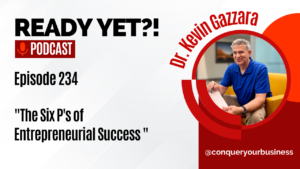your decision making muscle
Since being a business owner makes you Chief Decision Maker, how do you improve your decision making muscles? Let’s dive into what makes for good…and bad….decision making.
Resources
Transcript
Transcribed by Otter.ai
All right, hello, hello, let’s get started. So I have said this before, and I’m probably not the only one to say this. But being a business owner is basically signing up to be the chief decision maker. Right? Businesses solve problems, business owners have to make decisions in order to keep solving problems, right? So if being a business owner equals being the chief decision maker, truthfully, your success is directly tied to your ability to make decisions, and then act on those decisions. Why? Because indecision, Indecision is basically standing still, when we don’t know what to do, we don’t do anything. And going along this idea of if you’re either growing or you’re dying, there is no standing still, in business, standing still means you’re not growing. The other thing about indecision, when we’re not able to make decisions, it means that more likely than not, you’re existing in reaction mode. If you don’t proactively decide what to do, then you’re actively deciding what to do. It means you’re always chasing something, instead of creating something. I’ll give you a non business example. If you’ve ever had surgery, I know this is a very weird non business example. But I love this term, I use it a lot for myself. So if you’ve ever had surgery, right, you know that there’s pain management done after the surgery, and most pain meds last four hours. So the nurse comes and checks in with you at about three, three, three and a half hours to determine how you’re doing so that they know what to do next. Do you need to stay on pain medication? Does it need to be adjusted in any way? And the reason they do that is because you never want to get into a situation where you’re chasing the pain. You don’t want to wait until things are so bad before you do something about it. So when you’re recovering from surgery, the idea is you never want to chase the pain.
Same thing in your business. It’s the same thing in your business. If you are waiting until a situation becomes a problem, and a problem becomes a catastrophe, before you are doing something about it. That puts you in a position where you are chasing the pain, pure reaction mode. The difference between an incident and a problem and the difference between a problem and a catastrophe is reaction mode. So in order to be proactive about your decision making, you have to be doing a few things right. So let’s get into some tactics here. If you’re going to be proactive about your decision making, you have to be doing a few things on a continual basis. Number one is tracking everything. You have to track everything. Data driven decisions are the antidote to knee jerk decisions. Data driven decisions are the antidote to knee jerk research decisions. The other thing you need is to have a vision. In order to make good decisions, you need to have a vision. Now, I don’t mean in this case, the morning routine, big picture vision, you need one of those also. But that’s not what I’m talking about here. I want to be more specific with this vision. You need to have boundaries as to what your business doesn’t doesn’t do. Right. In order to make good decisions. You need to have a vision and that vision is vows. What does your business do? And not do so that you don’t have scope, creep or service creep or find yourself doing things that you didn’t actually mean to do. But living in reaction mode, you ended up there.
I’ll give you another way to think about this. When I was in school for my MBA, everything’s a case study. That’s like an MBA teaches you how to think about things and everything is a case study. And so lots of reading books, lots of studying what other companies have done and one of the books they have you read I don’t know if this is still very popular. But the book is good to write a review of how good companies become great companies. And one of the chapters is all about getting the right people on the bus. You just need the right people on the bus. You just need the right people on the bus. Not wrong however This is why you need a vision. The right people won’t get on a bus, if they don’t know where it’s going. The right people, whether it’s your team, or your clients will not join you. If they don’t know where you’re going, the vision you have for your business has to be uber clear. So that people are attracted to you because of the certainty that you’re offering. So we need to track everything. So with data driven decisions, we need to have a vision, clarity around what it is we’re trying to create and what those next steps will lead us to. So that we have boundaries, and that we can attract the right people both as part of our team, part of our network and part of our clients.
The third thing is you have to know your priorities. In order to make good decisions, you have to know your priorities. What are you working on? Now? You can’t cross two bridges at once. You can’t chase two bunnies, right? What are your priorities? What are the most important things that are happening right now that you want to focus on? So that you can make good decisions? The fourth thing is constantly analyzing, analyzing, analyzing, analyzing, it’s not enough to track what’s going on. If you never look at the information. Where is the intersection? This is my favorite question asked, I asked myself this all the time. If you’ve watched me at all, if you’ve watched the iterations of conquering your business, and we’re working on our next iteration right now, it is because of the answer to this single question. Where is the intersection between the problem your ideal client has, and the problem you are awesome at solving? You have to be analyzing and asking yourself that all the time and making your decisions based on the answer that question, where is the intersection between the problem your ideal client has, and the problem you are excellent at solving this answer moves, it moves with the market, it moves with your evolution, you need to make sure you are moving with it.
The biggest problem I am seeing right now, in the small business world, is people who are not moving along with the fact that the answer to this question has moved, at least slightly. For most people, for most people, the answer to the question of where is the intersection between the problem your ideal client has, and the problem that you’re excellent at solving has adjusted and moved. If you don’t move with it, you get knocked back to reaction mode, which we’ve already said is not the place we want to be. You can’t create things out of reaction mode. So we know we need to track everything we know we need to have a vision and clarity about what we’re doing. We know we need to keep our priorities straight, so that we’re focused on the right thing. And we need to analyze, analyze, analyze all the time, to help us make good decisions. This is not a once a year thing. This is not a once a quarter thing. This is not a once a month thing. This is something that I look at constantly, weekly, weekly, weekly, and sometimes daily, if I’m really digging into something. So there’s two things that will screw this up for us over and over and over again, right? If those are the things you need to get good at, to build your decision making abilities, what’s going to mess you up, right, let’s give you some pitfalls to look out for. There’s two things that mess us up over and over and over again. They don’t just mess up decision making in your business. They’ll mess up decision making in your life, in your health, in your money, in your relationships. The first one is desperation. If you are desperate, and I know that’s a heavy word, but if you are desperate for money,then you are going to make some bad decisions because you are going to chase the money instead of creating something with intention that has a greater outcome for you down the road.
If there is any part of your behavior that is acting out of fear and desperation that will cause bad decision making. The second thing that causes bad decision making is insecurity. If you are being driven by needing people to like you, if you’re worried about whether or not you will succeed or fail, instead of just understanding that each decision is just an opportunity to collect more data so that you can make a better decision. Right those insecurities if you don’t trust yourself to make good decisions, those situations that that desperation, those insecurities will inherently cause bad decision making. So you always want to check your motivations before you’re making your decisions. So how do you get better than if we had a list already of what needs to happen? And a list of two things to avoid? What? How do you get better at making decisions, you get better by making more decisions. This is not one of those things you could think about in order to get better. This is a thing that you do to get better, make more decisions, you make more of them. And then you reflect and debrief. You reflect and debrief, how did it go? You made a decision? How did it go? What instinct did you have that you ignored? Right? Don’t go on that date. Don’t walk down that dark alley, don’t take that job? What instinct did you have that you ignored? Before you made that decision? Where did you not do enough to make your decision work? So did you make a decision? But then you didn’t really do the work necessary? For that decision to be successful? Be honest with yourself, this is all just data? And also, where did you give it your best? And how did that affect the outcome of your decision? Where did you go all out? And do a great job? And what was the effect that that had on your decision? And here’s a big one. For me. I learned this one the hard way.
So let’s shortcut your learning curve here. What questions did you not ask? Before you made your decision? That would have helped you make a better decision? I’ll say that again? Because it’s a complicated sentence. What questions did you not ask, before you made your decision? That if you would have asked them, you would have been able to make a better decision. And I’ll give you an example of that. I joined a coaching program. And I will tell you, I have done this more than once. So don’t do it this way. I’ve joined more than one coaching program, where I didn’t ask them. I didn’t ask them. What else was I going to need to invest in? To make sure that what I learned from them, I could actually implement? I didn’t ask What else I was gonna need to invest. And I joined a coaching program more than once, don’t do it this way. Where I literally didn’t have the resources to take action on what I was learning. It didn’t have the resources to take action on what I was learning, because I didn’t ask good enough questions before I made that decision. So that is one of my favorite, favorite favorite questions to ask myself or whomever I’m talking to. What else will I need to invest in in order to make sure that this is a good decision? Very, very, very, very, very, very important. And if they do, if you’re talking about working with someone else, they should be able to answer that for you. So pay attention to your decision making. If you want your business to grow, one of the number one muscles you can build is your decision making muscle. So go out there and grow this muscle. Thanks





